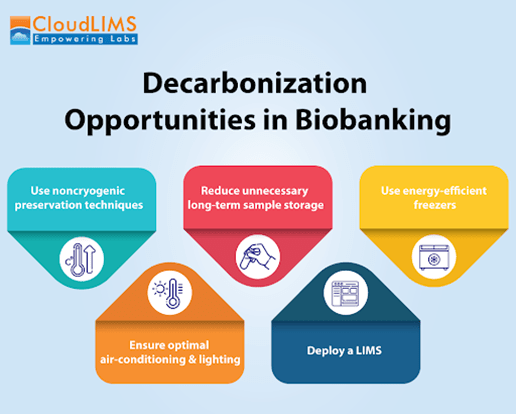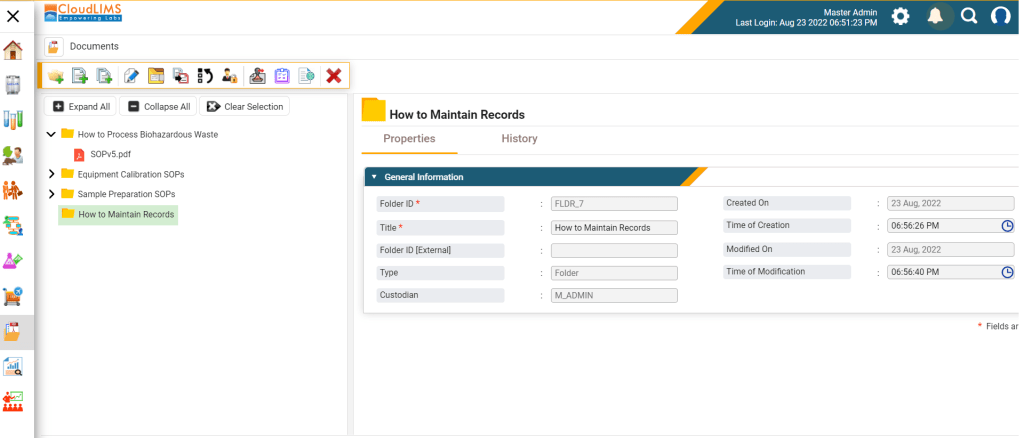
Green Tech for Greener Biobanking: How Biobank Software Leads the Decarbonization Drive
The need for decarbonization is becoming increasingly urgent as the world grapples with the severe consequences of climate change. With growing emphasis on reducing carbon emissions across various industries, it is inevitable that the energy-intensive nature of biobanks, responsible for storing valuable biological samples, comes under scrutiny. Biobanks, essential repositories of biological materials, play a critical role in scientific research, healthcare advancements, and drug development. However, their operations, often relying on energy-intensive cooling systems, freezers, and high-tech equipment, contribute significantly to carbon emissions.
In this article, we delve into the challenges and opportunities for decarbonization in biobanking.
The Overlooked Sustainability Challenge in Biobanks
In recent decades, biobanks have experienced exponential growth, leading to a significant surge in their storage requirements. This remarkable expansion has raised environmental concerns, but surprisingly, the concept of sustainability within biobanks has not adequately incorporated environmental considerations. A 2022 study by Taylor & Francis Group revealed a lack of awareness among key stakeholders, including researchers utilizing biobank resources and digital sustainability experts. Moreover, environmental sustainability policies within biobanks are virtually non-existent despite their status as public goods and their reliance on public funding. This concerning gap in policies and discussions neglects the substantial ecological impact of biobanks, which demands thoughtful evaluation in terms of governance and overall sustainability.
Decarbonization in Biobanking: The Roadblocks
The primary hurdle in achieving decarbonization within biobanking closely relates to the task of cutting down energy usage. Most biobanks rely on electricity-powered ultracold freezers; consequently, the central concern is about reducing the electric energy consumption of deep freezers, such as those operating continuously at approximately -80°C.
Another energy-intensive aspect of biobanking pertains to the utilization of liquid nitrogen (LN2). The rationale behind opting for LN2 instead of electricity for long-term storage of biological samples lies in its capacity to achieve lower temperatures, creating a highly stable ultralow-temperature environment. However, the challenge lies in the limited availability of information regarding energy consumption specifically related to regular LN2 usage, although other aspects of LN2 consumption, such as its safety for staff in terms of occupational accidents, are well-documented. To effectively plan, execute, and assess decarbonization efforts in biobanking, it is crucial to gain a comprehensive understanding of the LN2 scenario within the industry.
The challenges faced by Low-and-Middle-Income Countries (LMICs) are distinct from those in High-Income Countries (HICs) because LMICs generally have less well-equipped facilities. Cost considerations drive their preferences, and acquiring high-quality deep freezers poses a significant financial challenge for LMIC biobanks. Low-cost freezers that consume more electricity and release more heat are the norm in these countries. These low-cost freezers often do not comply with CFC/hydrochlorofluorocarbon (CFC/HCFC) regulations and do not use environmentally friendly reagents.
Opportunities for Decarbonization in Biobanking in LMICs and HICs
LMIC biobanks can pursue decarbonization despite the obstacles they face. Implementing intelligent strategies and adopting behavioral changes can promote eco-conscious practices. For instance, implementing a just-in-time model can effectively decrease the need for long-term sample storage in LMIC biobanks. This approach enables these biobanks to focus on prospective collections and short-term storage while actively collaborating with stakeholders to fulfill their specific needs. Another frugal way to support decarbonization involves using applications that enable the pooling of samples from various locations by a single individual or vehicle. LMIC biobanks may also explore the adoption of diverse supplementary actions. These could entail the use of energy-saving office lighting, optimizing heating and cooling systems, promoting a paperless environment within the biobank, and incorporating an energy star rating as a purchasing criterion for equipment to encourage manufacturers to prioritize energy-efficient designs for future equipment.
HICs, on the other hand, have the capability to embrace advanced technologies that offer higher energy and LN2 efficiency. These technologies should undergo rigorous testing and, upon successful validation, must be gradually integrated into existing biobanking facilities and networks. Additionally, HICs need to develop methods that enable the storage of larger quantities of samples at room temperature, effectively reducing the heating and cooling requirements for equipment.
Figure 1: A diagrammatical depiction of the decarbonization opportunities in biobanking (Figure courtesy of CloudLIMS).

How Can Biobank Software Help Decarbonize Biobanks?
A biobanking LIMS can help biobanks mitigate their environmental impact. First and foremost, it eliminates the need for paper-based records and documentation. This transition to digital documentation decreases reliance on paper, thereby reducing the carbon footprint associated with paper production, transportation, and disposal. With the adoption of digital documentation and biobank software, biobanks can effectively minimize their ecological footprint while simultaneously enhancing the record-keeping efficiency of biobanks. Furthermore, employing biobank software that operates on the public cloud, such as AWS and Google Cloud, enables multi-tenancy and sharing of resources across various users, promoting seamless real-time collaboration and diminishing individual carbon footprints.
Figure 2: A biobanking LIMS to manage samples and associated metadata digitally (Figure courtesy of CloudLIMS).

Conclusion
Despite the increasing awareness and actions taken to reduce carbon footprints in other sectors, the conversation about environmental sustainability in biobanking remains relatively absent. As the world strives to address the environmental challenges and transitions towards a sustainable future, it is crucial for the biobanking community to actively engage in discussions about adopting greener practices, optimizing energy consumption, and exploring eco-friendly alternatives without compromising the integrity and preservation of valuable samples. There’s no denying that challenges exist, especially in LMICs, where decarbonization might entail additional financial costs they may not be able to afford. However, with some ingenuity and behavioral and operational changes, and embracing a cloud-based biobank software and going paperless, LMICs can also work towards decarbonization. Embracing sustainable practices and adopting innovative technologies are essential steps in ensuring a greener and more sustainable future for biobanks. By embracing sustainability in biobanking, the industry can not only contribute to the broader global decarbonization efforts but also ensure the long-term viability and societal benefits of these invaluable repositories of biological resources.
About CloudLIMS:
CloudLIMS.com is an ISO 9001:2015 and SOC 2-certified informatics company. Their SaaS, in-the-cloud Laboratory Information Management System (LIMS), CloudLIMS, offers strong data security, complimentary technical support, instrument integration, hosting and data backups to help biorepositories, analytical, diagnostic testing and research laboratories, manage data, automate workflows, and follow regulatory compliance such as ISO/IEC 17025:2017, GLP, 21 CFR Part 11, HIPAA, ISO 20387:2018, CLIA, ISO 15189:2012, and ISBER Best Practices at zero upfront cost. Their mission is to digitally transform and empower laboratories across the globe to improve the quality of living.
About Astrix:
Astrix partners with many of the industry leaders in the informatics space to offer state of the art solutions for all of your laboratory informatics needs. Through world-class people, process, and technology, Astrix works with clients to fundamentally improve business, scientific, and medical outcomes and the quality of life everywhere. Founded by scientists to solve the unique challenges of the life science community, Astrix offers a growing array of fully integrated services designed to deliver value to clients across their organizations.
About The Author:

Montserrat Valdes is a highly skilled chemical engineer with a diverse background in research and industry. She holds a Master of Science degree in Chemical Engineering from the University of Saskatchewan and an Analytical Chemistry Diploma from the National Autonomous University of Mexico. Currently, Montserrat is working with CloudLIMS.com as a Scientist.
Montserrat is an experienced chemist with expertise in the analysis of cannabis and nicotine-containing products. As a QC Chemist and Analytical Chemist, she has conducted numerous accredited testing methods to ensure the quality and compliance of cannabis products. Her experience also includes validating analytical testing methods and operating, calibrating, and troubleshooting a variety of analytical instruments, including HPLC-FLD/DAD/VWD, IC, and LC-MS.
In addition to her work as a chemist, Montserrat has also served as a Research Engineer, successfully coordinating various environmental projects of great importance. These projects include the simultaneous capture of NH3 and H2S using nanoparticles, the biodegradation of surrogate naphthenic acids, and the adsorptive removal of antibiotics from livestock waste streams.
Montserrat has also made significant contributions to scientific literature through her research articles and conference presentations. Her publications in journals such as the Journal of Environmental Chemical Engineering and Bioprocess and Biosystems Engineering highlight her expertise in topics ranging from nanotechnology applications to biodegradation and wastewater treatment.
Related
Case Study: LabWare Centralized Data Review for a Global Biopharmaceutical Company
Overview A global biopharmaceutical company specializing in discovery, development,... LEARN MOREWhite Paper: Managing Data Integrity in FDA-Regulated labs.
New White Paper LEARN MORELET´S GET STARTED
Contact us today and let’s begin working on a solution for your most complex strategy, technology and staffing challenges.
CONTACT US



